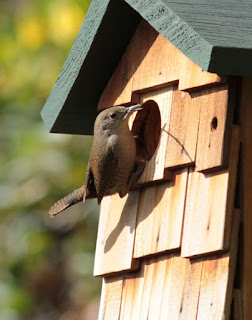 |
| A pair of House Wrens started building a nest in this box on March 27. Photo by J.J. Meyer |
Western bluebirds, Bewick's wrens and house wrens are among the most common cavity-nesting songbirds in Orange County. Other cavity nesting species include tree swallows, purple martins, wood ducks, chickadees, titmice, nuthatches, woodpeckers, flickers, American kestrels, barn owls and screech owls.
Installing a nest box can be beneficial. Bluebirds were on the decline until the Southern California Bluebird Club, a local conservation group, began hanging boxes in parks, cemeteries and other open spaces across the county. With limited natural cavities, such as woodpecker holes, bluebirds adapted quickly to the man-made boxes.
Although a nest box can be considered a birdhouse, not all birdhouses are functional nest boxes. Cute and whimsical appeals only to humans, so most colorful birdhouses are little more than garden ornaments.
According to the Cornell Lab of Ornithology, a nest box needs specific features to be functional and safe for the birds. The box needs to be the right size for the species you're trying to attract. For example, wrens are happy with an 8-inch-tall house and a 4-by-6-inch base. Wrens also need a 11/4-inch hole, which is large enough for them but small enough to keep out any larger uninvited guests. Perches are unnecessary and may attract larger predatory birds. The box should be made of untreated, unpainted wood with adequate ventilation and drainage holes. Grooved interior walls are necessary for the birds to climb out.
A box should always have a door that opens for cleaning it out at the end of the season. It also needs an extended, sloped roof to prevent raccoons and other predators from standing on top and reaching in. And the roof should be constructed of wood instead of metal, which can cause the birds to overheat inside.
Get more information about nesting birds and boxes at: Nest Watch.
Happy Birding!
J.J.
No comments:
Post a Comment